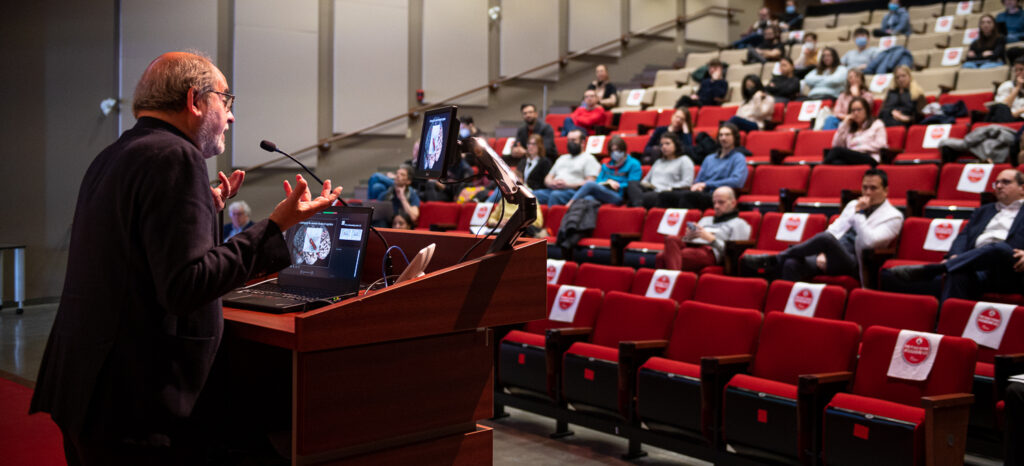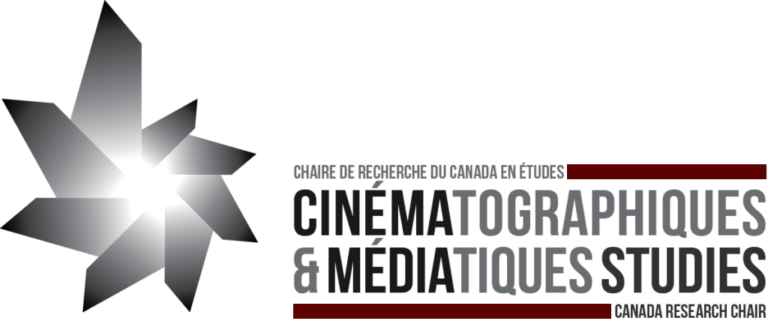Based at the University of Parma and headed by Vittorio Gallese, the Neuroscience & Humanities Lab is, like cinEXmedia, carrying out a variety of intersectoral projects which combine the arts and the neurosciences.

Olivier Du Ruisseau
The Italian researcher Vittorio Gallese is a longstanding cinEXmedia collaborator. Not only did he inaugurate the Canada Research Chair in Film and Media Studies “Distinguished Speaker” lecture series last year; his Neuroscience & Humanities laboratory, based at the University of Parma, also carries out a number of intersectoral projects with the partnership. He is even thinking of developing a new international Master’s program with the Université de Montréal which would combine the arts and the neurosciences.
Vittorio Gallese’s collaboration with cinEXmedia arose out of the publication of his book The Empathic Screen: Cinema and Neuroscience (2019). In this volume, co-authored by the film historian Michele Guerra, he attempts to explain the cinema experience from the perspective of film viewers through the prism of the neurosciences. In particular, he proposes a new model of perception – “embodied simulation” – in order to demonstrate the role of cerebral sensorimotor circuits associated with affect in cognition and the cinema experience.
André Gaudreault, founder of cinEXmedia, and Santiago Hidalgo, executive director of the partnership, were particularly struck by this volume, given that they too are carrying out intersectoral work on cinema and the neurosciences. Their recent projects with the Centre de recherche de l’Institut universitaire de gériatrie de Montréal (CRIUGM) are a good example of this.
The two researchers thus contacted Vittorio Gallese in 2020 to ask him if he would like to become a member of cinEXmedia after they had applied for funding from the Social Sciences and Humanities Research Council of Canada. He later gave two lectures at the Université de Montréal in the spring of 2023, and André Gaudreault was hosted as a guest researcher at the University of Parma last fall.
Interview – For an Experience of Cinema “by the Body”
To learn more about the work this Italian neuroscientist carries out at his laboratory, and to better understand how the cinema experience can be studied empirically, we spoke with him by videoconference. The following is a condensed version of our discussion.
How did you begin to work at the intersection of cinema and the neurosciences?
In the beginning I was a researcher and professor in neurosciences. It was only in working with Michele Guerra while writing The Empathic Screen that I began to become interested in the way in which cinema can be experienced from a neuroscience perspective, in particular because too few studies had been carried out on the subject before then.
This is also why we established the Neuroscience & Humanities Lab. We see this organization as a platform for creating links between the neurosciences and various fields in the humanities. The Lab principally organizes webinars, seminars and lectures where guests from every horizon can learn from one another. Our guests cover quite varied topics, from the impact of artificial intelligence on artistic creation to how empathy functions in aesthetics. We have hosted Siri Hustvedt and Jessica Grahn, for example, as well as Michele Guerra, of course.
How is it that still today so few researchers in cinema studies incorporate applied science in their work?
It is mostly because historically the film experience has not been seen as corporeal and sensorial. For decades, the dominant paradigm was classical cognitivism, according to which the body basically acts like a device holding up the brain. In addition, too few researchers dare to explore fields they are not familiar with. It took me several years to familiarize myself with film theory and history before being able to write about it.
In addition, in its early years many writers addressed the question of cinema’s reception by the body and why audiences reacted strongly to films. But most of the theories that followed on from this in the twentieth century were not really interested in the body – from film analysis to psychoanalysis by way of the work of David Bordwell for example. Fortunately, a new generation, of which I am a part, is beginning to remedy this situation. Greater numbers of researchers are even employing the concept embodied simulation, about which I have written a great deal in the past few years.
How do you ensure that you are gathering reliable data when you carry out empirical observations on the cinema experience? It must be almost impossible to study every factor influencing the brain’s response to audiovisual content.
In fact one must isolate and measure one factor at a time. It is also very difficult to reconstruct in a laboratory a typical cinema experience in a movie theatre. If you come to my laboratory, you will wear a helmet connected to a computer and you will be surrounded by equipment.
Even so, I believe that our experiments yield concrete and consistent results. For example, we have been able to observe, on the level of participants’ brains, different reactions to camera movements in the clips they are shown. In another experiment, we were able to observe the strongest reactions when participants saw films in which the 180-degree rule, one of the principles of classical Hollywood editing, was not observed. We have also been able to compare the effect of kinds of sound equipment – mono, stereo, multi-channel – on viewers’ emotional response. So we proceed one factor at a time, but obtain good results just the same.
***
International Master’s Program
At the conclusion of the interview, Vittorio Gallese explains that he is also trying to set up an international master’s program which will combine the arts, the neurosciences and the humanities. “André Gaudreault has expressed a great deal of interest in us working with the Université de Montréal, he says, but on my side persuading the university community to take part in this kind of project is very complicated”.
“An enormous amount of work remains to encourage universities to carry out research projects and offer courses which adopt intersectoral approaches”, Gallese concludes. “It was thus very stimulating for me to learn that a laboratory such as CinéMédias is exploring this and that we could work together”.

